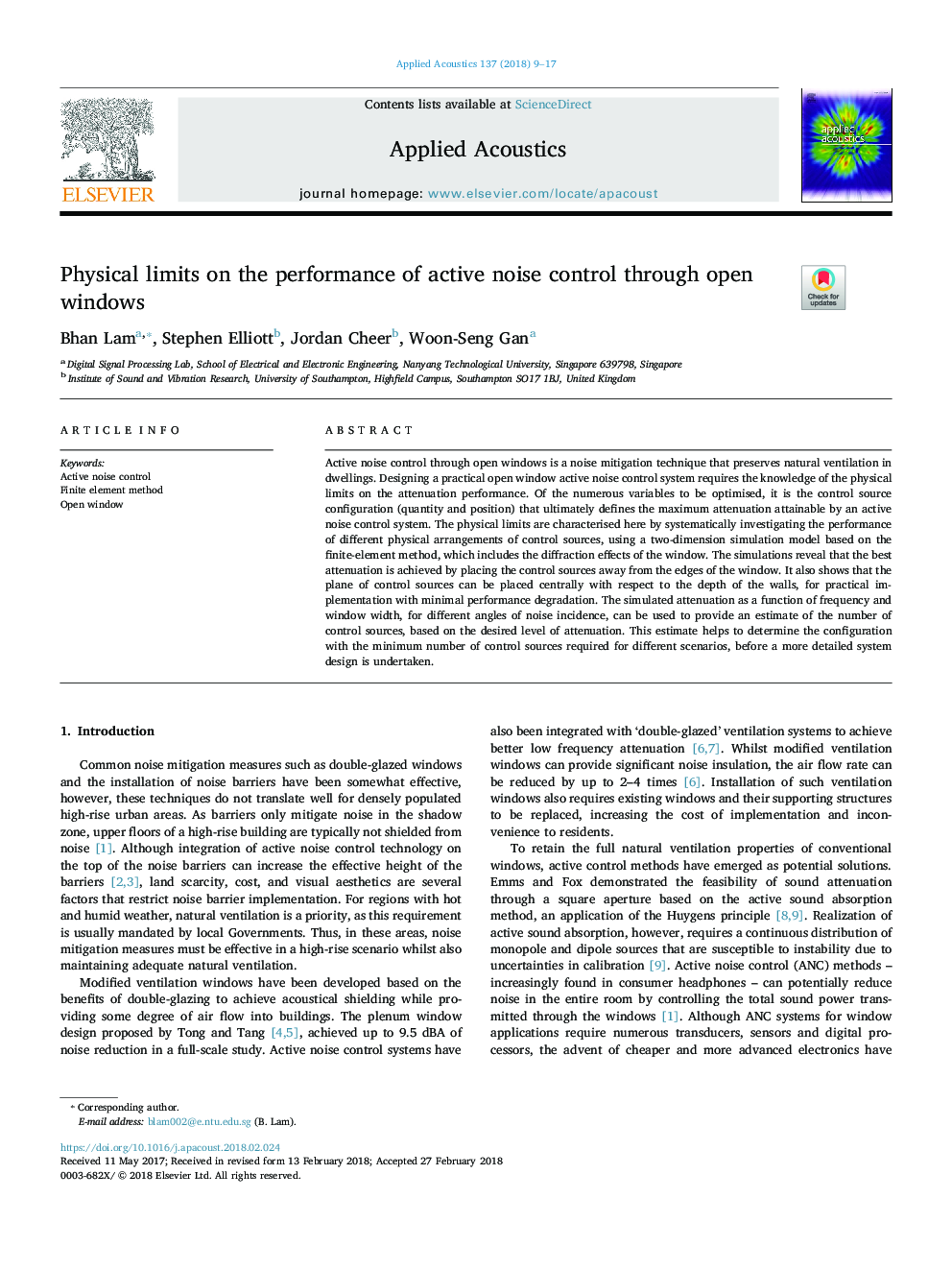| کد مقاله | کد نشریه | سال انتشار | مقاله انگلیسی | نسخه تمام متن |
|---|---|---|---|---|
| 7152196 | 1462373 | 2018 | 9 صفحه PDF | دانلود رایگان |
عنوان انگلیسی مقاله ISI
Physical limits on the performance of active noise control through open windows
ترجمه فارسی عنوان
محدودیت های فیزیکی در عملکرد کنترل نویز فعال از طریق پنجره های باز
دانلود مقاله + سفارش ترجمه
دانلود مقاله ISI انگلیسی
رایگان برای ایرانیان
کلمات کلیدی
کنترل نویز فعال، روش عنصر محدود پنجره باز،
ترجمه چکیده
کنترل نویز فعال از طریق پنجره باز، یک روش کاهش صدا است که تهویه طبیعی در خانه ها را حفظ می کند. طراحی سیستم کنترل نویز فعال سیستم باز، نیاز به شناخت محدودیت های فیزیکی در عملکرد آسیب پذیری دارد. از متغیرهای متعدد برای بهینه سازی، پیکربندی منبع کنترل (مقدار و موقعیت) است که در نهایت تعریف حداکثر کاهش قابل ملاحظه توسط سیستم کنترل نویز فعال است. محدودیت های فیزیکی در اینجا به صورت سیستماتیک بررسی عملکرد تسهیلات مختلف فیزیکی منابع کنترل، با استفاده از یک مدل شبیه سازی دو بعدی بر اساس روش المان محدود که شامل اثرات پراکندگی پنجره می باشد، مشخص می شود. شبیه سازی ها نشان می دهد که بهترین انقباض با قرار دادن منابع کنترل از لبه های پنجره به دست می آید. همچنین نشان می دهد که سطح کنترل منابع می تواند با توجه به عمق دیوارها به طور مرکزی قرار گیرد، برای اجرای عملی با حداقل تخریب عملکرد. ضریب شبیه سازی شده به عنوان تابع فرکانس و عرض پنجره، برای زوایای مختلف میزان بروز نویز، می تواند برای ارزیابی تعداد منابع کنترل بر اساس سطح مطلوب خنثی استفاده شود. این برآورد به تعیین پیکربندی با حداقل تعداد منابع کنترل مورد نیاز برای سناریوهای مختلف کمک می کند تا قبل از طراحی سیستم دقیق تر انجام شود.
موضوعات مرتبط
مهندسی و علوم پایه
سایر رشته های مهندسی
مهندسی مکانیک
چکیده انگلیسی
Active noise control through open windows is a noise mitigation technique that preserves natural ventilation in dwellings. Designing a practical open window active noise control system requires the knowledge of the physical limits on the attenuation performance. Of the numerous variables to be optimised, it is the control source configuration (quantity and position) that ultimately defines the maximum attenuation attainable by an active noise control system. The physical limits are characterised here by systematically investigating the performance of different physical arrangements of control sources, using a two-dimension simulation model based on the finite-element method, which includes the diffraction effects of the window. The simulations reveal that the best attenuation is achieved by placing the control sources away from the edges of the window. It also shows that the plane of control sources can be placed centrally with respect to the depth of the walls, for practical implementation with minimal performance degradation. The simulated attenuation as a function of frequency and window width, for different angles of noise incidence, can be used to provide an estimate of the number of control sources, based on the desired level of attenuation. This estimate helps to determine the configuration with the minimum number of control sources required for different scenarios, before a more detailed system design is undertaken.
ناشر
Database: Elsevier - ScienceDirect (ساینس دایرکت)
Journal: Applied Acoustics - Volume 137, August 2018, Pages 9-17
Journal: Applied Acoustics - Volume 137, August 2018, Pages 9-17
نویسندگان
Bhan Lam, Stephen Elliott, Jordan Cheer, Woon-Seng Gan,
